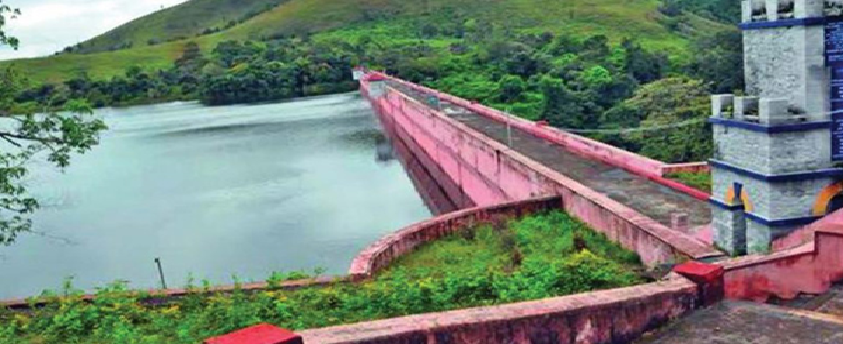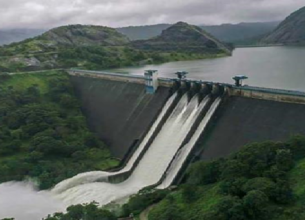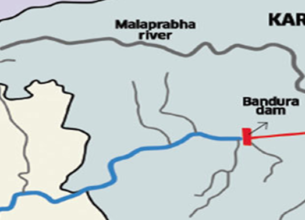Tamil Nadu reiterates stand over Mullaperiyar level
07, Jan 2022

Prelims level : Rivers
Mains level : GS-III Conservation, Environmental Pollution and Degradation, Environmental Impact Assessment.
Why in News?
- Tamil Nadu has once again asserted its stand on sharing of river water with neighbouring states by declaring its intention to take necessary steps to restore the full reservoir level (FRL) of 152 ft in Mullaperiyar Dam located in Kerala.
About Mullaperiyar Dam:
- The Mullaperiyar Dam is a masonry gravity dam on the Periyar River in the Indian state of Kerala.
- The dam situated at the confluence of the Mullayar and Periyar rivers
- It is located 881 m (2,890 ft) above mean sea level, on the Cardamom Hills of the Western Ghats in Thekkady, Idukki District of Kerala, South India.
- It was constructed between 1887 and 1895 by John Pennycuick and also reached in an agreement to donate water eastwards to the Madras Presidency area (present-day Tamil Nadu).
- The Periyar National Park in Thekkady is located around the dam’s reservoir.
- The dam is located in Kerala on the river Periyar, but is operated and maintained by Tamil Nadu state.
- Dam was given to British-ruled Madras Presidency on a 999-year lease in 1886.
- The agreement was renewed in 1970.
- Tamil Nadu was given rights to the land and the water from the dam as well as the authority to develop hydro-power projects at the site, and Kerala would receive rent in return.
About Periyar River:
- The Periyar River is the longest river in the state of Kerala with a length of 244 km.
- It is also known as ‘Lifeline of Kerala’ as it is one of the few perennial rivers in the state.
- A perennial river is a channel that has continuous flow in parts of its stream bed all year round.
- Periyar River originates from Sivagiri hills of Western Ghats and flows through the Periyar National Park.
- The main tributaries of Periyar are Muthirapuzha, Mullayar, Cheruthoni, and Perinjankutti.

What is the Controversy?
- For Tamil Nadu, the Mullaperiyar dam and the diverted Periyar waters act as a lifeline for Theni, Madurai, Sivaganga and Ramnad districts, providing water for irrigation and drinking, and also for generation of power in Lower Periyar Power Station.
- Tamil Nadu has insisted on exercising its unfettered rights to control the dam and its waters, based on the 1886 lease agreement.
- Kerala has pointed out the unfairness in the 1886 lease agreement and has challenged its validity.
- However, safety concerns posed by the 119-year-old dam to the safety of the people of Kerala in the event of a dam collapse have been the focus of disputes from 2009 onwards.
- Kerala’s proposal for decommissioning the dam and constructing a new one was challenged by Tamil Nadu.
- Idukki district, where the dam is located, is earthquake-prone and has experienced multiple low-intensity quakes. So, the dam is situated in a seismically active zone.
- A 2009 report by IIT Roorkee stated that the dam “was likely to face damage if an earthquake of the magnitude of 6.5 on the Richter scale struck its vicinity when the water level is at 136 feet”. It poses danger to life and property to three million people living in the vicinity of the reservoir living downstream.
- In early August 2018, on Mr. Joy’s plea, the court agreed with the conclusion of the disaster management sub-committee that the water level in the reservoir should be maintained two or three feet below the permissible limit of 142 feet till August 31 as an immediate precaution to Guard against Floods or other Disasters.
- The sub-committee had met on an urgent basis in the aftermath of the deluge that ravaged Kerala where the dam is located. It informed the court that the water level in the reservoir was 139.998 feet.
What is Tamil Nadu’s Stand?
- The Tamil Nadu Government has so far stood firm by its position in the court that the dam is “hydrologically, structurally and seismically safe”. It had blamed a “social media campaign” triggered in Kerala against the dam.
- It said the steady flow of petitions to the court from Kerala, questioning the dam’s safety, even calling for its decommissioning, was a bid to harass it.
- It accused Kerala of trying “somehow to prevent Tamil Nadu to raise the level to 142 ft. at the Mullaiperiyar dam on one pretext or the other by raising issues which have been fully addressed by experts from Central Water Commission [CWC]”.
- Tamil Nadu, in an affidavit, noted that the safety of the dam had been supported by reports of the expert committee and the empowered committee after extensive study. The height of storage level of the dam at 142 ft. was endorsed by the court in 2014 in a judgment.
- The safety aspects of the dam were being constantly monitored by the Supervisory Committee set up seven years ago.
What is Kerala’s Demand?
- Kerala, in turn, has demanded a reconsideration of the rule curve, as the dam was situated in a seismic zone. It accused Tamil Nadu of adopting an “obsolete” gate operation schedule dating back to 1939.
- The court is hearing a petition filed by Idukki resident Dr. Joe Joseph and office-bearers of the Kothamangalam block panchayat in Kerala expressing their apprehensions about the lack of proper supervision of water levels in the dam located along the Periyar tiger reserve.
- The petitioners, including Dr. Joseph, had accused the Supervisory Committee of having become “lethargical” in the safety inspection and survey of the dam, saying it has delegated its duties to a sub-committee of local officials.
- Idukki-based Periyar Protection Movement alleged that there was “deep” seepage issues in the dam structure.
- Tamil Nadu cannot dismiss the apprehensions of 50 lakh people in Kerala about the dam’s safety by calling it a Social Media Campaign.








